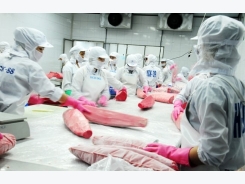Canada holds promise for Vietnam farms

HÀ NỘI — Although Canada is a major producer of seafood, it still imports a variety of sea products from Việt Nam, especially black tiger shrimps.
According to Việt Nam’s General Department of Customs, last year, Việt Nam’s seafood export turnover to Canada reached more than US$183 million. This was the highest figure for agricultural products exported to the Canadian market.
In the first 10 months of this year, seafood exports to Canada have leapt significantly. Turnover so far is more than $186 million.
Nguyễn Như Tiệp, director of the National Agro-Forestry Fisheries Quality Assurance Department (NAFIQAD), said Canada had one of the strictest import regulations for farm products, especially seafood.
However, as it is a high value market, learning to comply with the system gives Viet Nam an advantage when selling to other countries.
In terms of seafood, Tiệp said Vietnamese shrimp products had the biggest sales opportunity in Canada because demand was quite large.
The standard of many shrimp raising and processing enterprises in Việt Nam now meets the requirements of Canada. However, the same is not true for farming in general.
In particular, Canada has shifted to management from the bottom up. Therefore, not only processing enterprises must be inspected, but also raw material areas must be assessed by Canadian authorities visiting Việt Nam to approve export licences.
To promote Việt Nam shrimp exports, Canada recently backed a $15 million technical assistance project to help businesses and farmers control food safety.
Nguyễn Đức Hòa, Vietnamese Ambassador to Canada, said Canada is a country with favorable natural conditions for agriculture and the world’s leading agricultural technology. Therefore, there is optimism that Vietnamese businesses will soon be allowed to directly invest in Canada’s agricultural production.
At present, a number of Vietnamese enterprises are visiting Canada to lease agricultural land. In addition, Canadian firms are interested in Việt Nam’s agriculture, including its adaptation to climate change.
The biggest problem with the Canadian market is that information and two-way understanding between Vietnamese and Canadian companies is still limited, according to Hòa.
Hòa suggested the Ministry of Agriculture and Rural Development should organise trips for delegations from Việt Nam to meet Canadian enterprises to seek specific co-operation opportunities.
Có thể bạn quan tâm
Phần mềm

Phối trộn thức ăn chăn nuôi

Pha dung dịch thủy canh

Định mức cho tôm ăn

Phối trộn phân bón NPK

Xác định tỷ lệ tôm sống

Chuyển đổi đơn vị phân bón

Xác định công suất sục khí

Chuyển đổi đơn vị tôm

Tính diện tích nhà kính

Tính thể tích ao hồ




 Use of Industry 4.0 technologies in aquaculture discussed
Use of Industry 4.0 technologies in aquaculture discussed  Ca Mau strives to earn 1.1 billion USD…
Ca Mau strives to earn 1.1 billion USD…